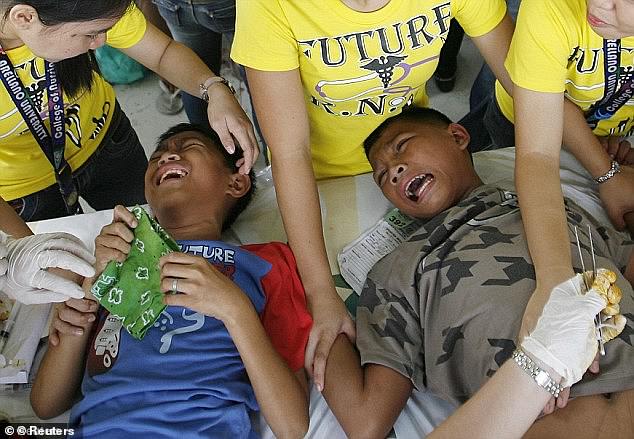From boys to men… in the most agonising way possible: World’s most gruesome initiations from ‘penis splitting’ ritual to ‘circumcision season’ and frog poison injections

For centuries, boys around the world have had to endure agonising initiation rituals to prove themselves as men in their communities.
Tribes in the Pacific still employ graphic hazing traditions to test the will of men rising through the social hierarchy, from having their penis split open with a stone knife to daring jumps from terrifying heights with only vine leaves supporting them.
In the Philippines, schools host spectacular mass circumcisions in an annual drive funded by the government – but unlicensed doctors in rural communities often deliver excruciating procedures under limited anaesthetic.
And in the depths of the Amazon rainforest, boys bide through the world’s most painful insect sting, wearing gloves filled with venomous bullet ants to show they have reached sexual maturity. Bites, they say, feel like a gun shot.
Others inject themselves with frog poison as bitter juice is dropped in their eyes, causing temporary blindness, and elders beat and rub them with poisonous leaves.
In parts of West Africa, tribal children are cut with razor blades and glass to imbue them with scars supposed to represent adulthood and identity.
Initiation rituals continue to thrive around the world, everywhere from frat-houses to lost corners of the jungle, as boys dare to become men. MailOnline looks at some of the most gruesome rites of passage still practiced today.

Young Filippino boys are traditionally circumcised during their school summer break

The Taiwanese military inducts marines in a brutal ten week programme

Children in Benin are scarred with sharp razors as they come of age

Men prove themselves by leaping from an ancient tower in Pentecost attached to vines
Penis split open with a knife
The Aborigines were the first people to arrive in Australia, and have developed unique customs apart from all the world over the last 65,000 years.
Some tribes practice gory coming-of-age rituals with young men to mark the occasion in a way nobody would be quick to forget.
The ritual consists of a young man being seated on a rock while his penis is split open with a stone knife, as he grits his teeth and howls in pain.
The procedure is unique to the Aboriginies, according to a 1983 medical review, and involves cutting through the urethra lengthwise.
Once slashed, the penis is pressed flat against the rock on which the young adult is sitting against, drastically altering its appearance.
This is supposed to make it ‘lighter’ and ‘more beautiful’.
This is to be repeated through adult life, and the subincised penis can be ‘used as a site for ritual bloodletting’.
When the ascended man walks into a strange camp, he can show he has gone through the process with a ‘ritual of penis holding’.
Young men are also scarred on their scars on their chests, shoulders, arms and backsides using a sharp rock throughout the ritual.
The wounds are then filled with sand to produce larger scars, which they embrace as a sign of bravery prowess.
As they await subincision, the boys’ bodies are painted with sacred symbols and decorated with bracelets as their guardians spit white clay on their faces.

Aboriginal teenager Jazmin painted up with his sacred dreaming ‘Milmildjarrk’ for his initiation ceremony into manhood at Yathalamarra, Arnhem Land

Teenager Jazmin being sprayed with white clay by his uncle for his initiation ceremony, Arnhem Land. The white clay is chewed in order to then spay it by spitting onto the boys face
Stung by ants with a sting like a gunshot
One of the most agonising rituals is practiced in the depths of the Amazon by one of Brazil’s oldest tribal group – the Satere-Mawe.
Teenage boys who have become sexually mature go through a unique transformation to manhood by daring ants with stings that feel like gunshots to pinch them.
Young men try to find mental calm as they hold up gloves packed with hundreds of crawling bullet ants inside.
The ants are not particularly dangerous to humans, but pack a punch with venom that can cause hallucinations, violent tremors and numbness around the body.
Dr Sam Robinson of the Institute for Molecular Bioscience said the bites each cause a ‘deep drilling pain you feel in your bones with sweating and goosebumps, quite unlike the 10-minute impact of a typical bee sting’.
The pain is said to last 12 to 24 hours after contact. Entomologists judge it the most painful insect sting known to man.
Men prepare themselves by dancing in a circle as a group as a Sateré elder blows smoke into the gloves.
Someone has to be first. The boys each take turns to plunge their hands into the gloves, stirring up the agitated ants.
Participants have been seen throwing themselves on the ground in agony as the ants inject poison into their central nervous system.
The ‘Waumat’ ritual finds the tribe its next leaders, people capable of suffering through hardship and coming out the other side.
As Amazonian tribes face existential threats from loggers, the practice has become all the more important to its communities.

One of the most agonising rituals is practiced in the depths of the Amazon by one of Brazil’s oldest tribal group – the Satere-Mawe – by which they have teenage boys who have become sexually mature to endure the the excruciating sting of bullet ants

The bizarre ritual consists of males willingly getting stung by the ferocious insects thousands of times during a ceremony that sees the boys place their hands in gloves that are densely packed with hundreds of ants crawling inside
Annual circumcision rituals
In the Philippines, boys traditionally get circumcised when they are just about to enter their teenage years.
Uncircumcised teens often end up being teased by their peers, but the price of social acceptance is a painful one.
‘Tuli’ is considered a rite of passage into manhood. Its origins are unclear, but has been linked to an old Islamic custom brought over before the Spanish arrived.
Today, the Philippines government funds annual circumcisions for young boys to ensure the practice is carried out hygienically.
Schools will host mass circumcision events to mark the rite of passage, which involves the cutting of the foreskin with a very sharp knife under local anaesthetic.
Usually, this extends only to cutting a dorsal slit, rather than removing the foreskin.
Most of these children are between the ages of eight and 12.
Groups wait in line as they see their classmates writhing around in pain under the knife, knowing it will soon be their turn.
Pain can be managed with drugs these days, though things can go wrong – and younger people tend to experience more discomfort.
But in rural areas the surgery is sometimes performed by non-doctors using crude methods.
Traditionally, village folk would anchor wood into the ground and place the foreskin over the sharp point at the other end.
The circumciser then would then place his knife lengthwise across the foreskin and bash down on the knife with a stick, severing it.

Images have long documented the agonising procedure, and the looks on the little boys’ faces say it all

A young boy whimpers while being circumcised. Uncircumcised teens often end up being teased by their peers, but the price of social acceptance is a painful one

Today, the Philippines government funds annual circumcisions for young boys to ensure the practice is carried out hygienically
Injected with frog poison and blinded
Brazil’s Matis Indians have to undergo a complex four-stage test to prove they are ready to grow up, exposing themselves to great danger and succumb to searing to agony.
Members of the tribe will inject themselves with ‘kambo’ frog poison and have painful bitter juice dropped into their eyes, occasionally causing temporary blindness.
This frog poison is seen as a curative substance and a purgative – that by purging it and going through its effects one becomes stronger and more alert.
Indeed, it does seem to have some anti-bacterial properties.
To acquire the toxin , tribesmen stretch the frog over a fire and scrape its secretions from its back before releasing it into the wild.
The participant then has his skin burned, the blister popped and the toxin – mixed with spit – applied.
Elders meanwhile brutally beat them with harsh stems of a rattan plant and will rub them with poisonous and powerfully irritating leaves.
The substance briefly calms the person, but within seconds the sensation turns to suffering as the poison seeps into the man’s bloodstream.
The poison results in a full purging of the stomach.
Today, Americans travel into the Peruvian Amazon to undergo the procedure as part of a wellness trend under the guidance of part-time practitioners.

A Matsés man receives frog poison. His arms and chest show scars from where the poison has been applied previously

A man undergoes the application of Kambo frog venom in Iquitos, Peru
Scarred with razors and glass
For centuries, body-marking has been used to show tribal association, proving association with a community or proud lineage.
These marks can be made on the skin using stones, razors, glass or knives to permanently etch decoration and drawings onto the skin as ancient African ‘tattoos’.
In Benin, several tribes use razor blades and glass to mark children as they come of age, identifying them with long family lineages.
Controversially, children as young as eight-years-old can be subjected to the practice in some tribes.
Each ethnic group has its own distinct scarring patterns and can identify each other based on the intricate lines and marks etched into the face and head.
Some cuts are on the tribe member’s face, others have cuts on their backs and stomachs when they reach puberty to show their courage.
After razor blades carve designs into their skin, children are given new names and have their hair shaved off, before being taken to a convent where an oracle will try to communicate with previous generations.
Scarification is becoming less common as neighbouring countries outlaw the practice – but some tribal members still want to carry the marks of their ancestors and keep the tradition alive.
Similar practices have also emerged independently in other parts of the world.
In Papua New Guinea some men cut their skin to look like crocodiles to represent their ‘crocodile spirit’, creating a rippled scarring to resemble the reptile’s scaly skin.
Well-decorated spirit houses welcome initiates to undergo a gory cutting process, usually carried out by their uncles over a period of an hour or two.
Once, lesions were carved out with sharpened bamboo.
Some today still pass out from the pain – but begin the process of a transformation that will forever change their lives.
In these huts, boys may spend months learning key survival skills from elders – raising a family, catching food and understanding of the local religion.

The Houeda ethnic group is one of a number of tribes in Benin, West Africa, which believes that scarring children, usually on their faces, will connect them with their ancestors

Some tribesman are now not letting their children be cut over fears for HIV and AIDS. Medical advice has warned sterile surgical instruments should be used but tribal chiefs often refuse
Slashed with blades before journeying for a month through a forest
In an initiation ritual like no other, young men in Senegal risk their lives to be inducted as adults in society.
In the remote village in the Ziguinchor region of Senegal, men can spend up to a month in the depths of a sacred forest, testing their prowess and endurance.
Preparation for the ‘Boukout’ is a lengthy process, with men forbidden from seeing or touching women from the point their heads are shaved en masse.
Organised by elders, the event and the ceremony draws families from all over the region to host the village – which changes location each time.
Some put themselves through unimaginable pain before entering the forest, going so far as to press nails through their noses to show their strength.
Others demonstrate their physical and spiritual force by making deep cuts into their bodies, or mouths, with knives.
A special root and amulets (Gris-gris) are used to provide protection to the wearer during the acts.
While inside the forest, only little girls are allowed to break the vow by bringing them little gifts of food.
And during the pilgrimage, families come together to live and work as a single community until the men return.
Those who survive the arduous journey return heroes, considered blessed – though not all make it back.

A man cuts himself to show his strength before venturing into the forest

Some put themselves through unimaginable pain before going on the spiritual journey
Gruelling military training camps
The island nation of Taiwan has a much shorter history than the tribes of the south Pacific, but has built its strong military culture to fend off invaders on strict traditions of gruelling rites of passage.
Just 15 men of a group of 31 passed a 10-week intensive training programme to become members of an elite team of AFP marines in 2022 after being subjected to intense physical and mental stress.
Trainees are allowed to sleep in stints of just five minutes, huddled together on a concrete floor before undergoing arduous physical tasks under constant abuse from their instructors – tests that will help graduates deal with the unparalleled stressors of war.
The trainers, all graduates of the same course, say the intention of the week of hell is not cruelty but to simulate the hardship of war, like extreme sleep deprivation, to see who has the stamina and guts to make it.
The days are spent marching through sewage-contaminated water, with one hours’ break every six to stop and chew down garlic, supposed to buffer the immune system.
Much of the training is spent at sea or in swimming pools, drilling trainees in how to hold their breath and stay afloat while in full equipment.
And should they bide through the exhaustion of all ten weeks, the journey ends with a 100 metre belly crawl over sharp rocks in the ‘road to heaven’.
‘I’m not scared of death,’ recruit Fu Yu, 30, told Reuters after completing the long road home in 2022.

The ‘road to heaven’, is the final obstacle course consisting of a stretch of rocks some 100 metres long over which the trainees have to scramble on their bellies

Much of the training is spent at sea or in swimming pools, drilling trainees in how to hold their breath and stay afloat while in full equipment
Daring dives supported by vines
In the South Pacific island of Pentecost, teens go through a very different rite of passage – with as much at stake if something goes wrong.
In the heart of the jungle, young men practice the daring tradition of Naghol land diving, often considered as the original bungee jumping.
But in this practice, boys fling themselves from wooden towers with nothing but tree vines to stop their fall.
The idea is to jump the highest, and land as close to the ground as possible.
They have no nets and no safety equipment, no water or cushions to soften the impact.
But the ancient practice is rich in in ritualistic importance, marking the transition from boyhood to manhood as one proves their courage.
The ritual starts with the construction of a wooden tower, usually 20 to 30 metres in height, which takes several weeks to build.
Once completed, those who have been selected to jump have vines tied to their ankles, which are designed to protect the boys from hitting the ground after their fearless leap.
Despite being secured by the barely-elastic vines that viciously tug on their legs on their way down to the ground, the ritual is extremely dangerous, and can sometimes even result in death if not done properly.
The death-defying is such a spectacle in itself that it has attracted hundreds of visitors from around the world to witness the ritual – including Queen Elizabeth II, who visited the island in 1974, with the daredevil divers performing their jumps in front of her majesty.

In the heart of the south pacific and deep in the jungle of Pentecost Island, young men practice the daring tradition of Naghol land diving

Men performing a ritual called Land Diving as they jump from a wooden tower with vines wrapped around their ankles




